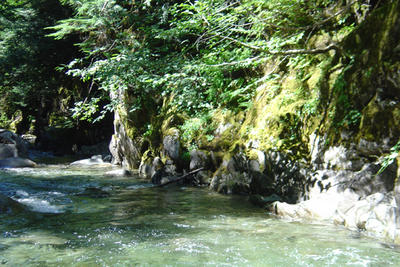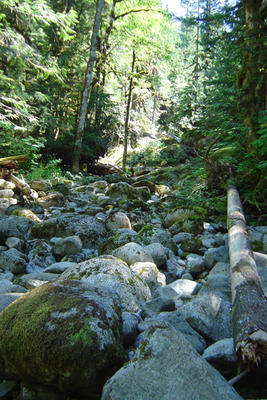
My plea for tips about Seattle led to the suggestion that I visit Vancouver instead. This Star-Tribune (Minneapolis) article - sorry, it is several weeks old - makes a very compelling case. It's here in its entirety, so you don't have to pay for it online.
HEALTHY BY DESIGN
Steve Berg | Star Tribune Editorial Writer
Published July 31, 2005
VANCOUVER, B.C.
http://www.startribune.com/stories/1519/5533882.html
Any busy downtown sidewalk will reveal the mystery of why Vancouverites
are an uncommonly vigorous and healthy bunch and why their city is so
widely admired.
Stand on Robson Street for five minutes on a weekday afternoon. Count
the people walking past: 346. Note the number who are obviously
overweight: 2. Estimate the number wearing backpacks: 100. Now take
another five minutes to count the cars moving steadily and easily past:
74 (plus two trucks and three buses). Reach for your calculator: 4.5
pedestrians for every car.
There you have it. Not exactly scientific proof, but an insight into
Vancouver's formula for healthy residents and urban vitality: more
walking, less driving.
More than any North American city, Vancouver has intentionally merged
public health with city planning. The goal is not just to promote
recreation (there are plenty of bike trails and tennis courts), but to
design physical activity into the daily routine, to build a city so
compelling that people will leave their cars at home, strap on a
backpack and take up walking as their primary mode of travel.
The result is a cityscape that's breathtaking in its beauty and
impressive in its retail vitality. Thick layers of trees and flowers
have invaded the downtown district. Strips of freshly trimmed green
grass line many downtown sidewalks. Hundreds of small shops and
restaurants have sprouted among the ever-expanding supply of townhouses
and high-rise condos. You can take a beautiful and pleasant walk to
fetch almost anything you need, so why drive?
Indeed, driving has become the backup mode of downtown travel. Growth in
auto traffic has lagged far behind growth in resident population, which
has doubled to 80,000 in the last 15 years. Auto traffic actually
declined by 13 percent between 1994 and 1999, according to a city
government study, while pedestrian traffic rose 55 percent. Last year,
vehicle registrations declined for the first time in memory as new
residents began eschewing second cars. Transit ridership, meanwhile,
rose 20 percent over three years. Air quality improved. And the
Vancouver region led Canada in many health categories, including life
expectancy.
"They built it and they live it," said Lawrence Frank, a planning
professor at the University of British Columbia and a leading expert on
the link between urban design and public health.
Both here, and earlier at Georgia Tech, Frank has been at the forefront
of research that ties obesity, hypertension, coronary disease, diabetes
and other health problems to the sprawling development and auto
dependence that dominates most cities. His and other research continues
to show that substituting even a modest amount of walking for driving as
part of the daily routine reduces the likelihood of obesity and related
diseases.
The greatest inducement to physical activity is living within walking
distance of shops, transit stops and other destinations, studies show.
In other words, urban form can induce a healthier lifestyle.
"Vancouver is the clearest example of that," Frank said. Critics suggest
that self-selection may have tilted his results -- that people who
choose to live in active cities tend already to be trim, fit and quite
literally "walking the talk." Frank acknowledges the point, but insists
that the policy implications remain valid. People will have a better
chance at a healthy life if cities build physical activity into the
urban form.
Vancouver owes its health-conscious design to a list of advantages that
most cities, including Minneapolis, don't have: a moderate climate, a
geography hemmed in by water and mountains, the relative racial harmony
among Vancouver's white and Asian ethnic groups, tax policies favorable
to renters and small business, a huge flow of Chinese investment since
the mid-1990s, and a contrarian strain of politics that engulfed the
city in the early '70s and continues to pay dividends.
"Those were the hippie-dippy days," recalls Gordon Price, an urban
planning consultant and former city councilor who says Vancouver
succeeds mostly because environmentalists kept freeways out of the
city's center.
As a result, traditional neighborhoods stayed intact; local streets
stayed vibrant and busy; crime was held in check; public schools and
small business remained strong. The city swallowed hard and accepted
high-density redevelopment as a way to preserve the wider region's lush
environment.
It was, in short, an early version of "smart growth" that ran contrary
to the trends of the day and to human nature. It would have been easier
just to acquiesce to sprawl, big-box stores and the auto lifestyle,
Price said.
Vancouver isn't without problems. Vagrants and drug addicts occupy
downtown's derelict eastern edge. Housing prices in the tonier West End
are leaving the middle class behind. Meanwhile, the outer ring is
suffering traffic woes common in most suburbs.
But what most impresses a visitor is central Vancouver's extraordinary
care for public spaces. While drivers tend not to notice, walkers are
drawn to beautiful spaces. They see their city close up. They won't
tolerate crumbling, weed-infested sidewalks or shabby neighborhood
businesses. The more walkers a city has, the more pleasant, safe and
vital it becomes. Every great city is a great walking city -- not only
through parks or along waterfronts, but along ordinary streets that link
homes and destinations.
For Vancouverites, the values of healthy physical activity, public
beauty and retail/residential success seem to have converged in a
perfect synapse.
How? A greenways program invests $1 million a year to build attractive
pedestrian and bicycle links between homes and destinations, sometimes
along "ordinary" city streets. In addition, the park system maintains
130,000 street trees as part of its impressive $80 million (U.S.) annual
budget, and the zoning ordinance requires private developers to devote 1
percent of construction budgets to public art, thus embedding scores of
sculptures, fountains and other artistic features into the walking
environment. Moreover, city planners routinely negotiate generous
landscaping commitments from private developers.
"They are expected to match the high standard that the city has set with
its landscape investments," said Sandra James, the city's chief
greenways planner.
The central idea in creating a healthy city, she said, is to make sure
that natural beauty isn't confined to parks and the waterfront but that
it invades every block.
Quoting the preamble to Vancouver's greeways policy book, she said:
"It's time to stop thinking of our cities as one place and nature as
someplace else."
Steve Berg is at sbe-@startribune.com.
(c) Copyright 2005 Star Tribune.







